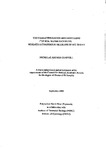THE CHARACTERIZATION AND MODELLING/OF SOIL WATER PATHWAYS BENEATH A CONIFEROUS HILLSLOPE IN MID WALES
| dc.contributor.author | CHAPPELL, NICHOLAS ARTHUR | |
| dc.contributor.other | School of Geography, Earth and Environmental Sciences | en_US |
| dc.date.accessioned | 2013-10-07T08:31:28Z | |
| dc.date.available | 2013-10-07T08:31:28Z | |
| dc.date.issued | 1990 | |
| dc.identifier | NOT AVAILABLE | en_US |
| dc.identifier.uri | http://hdl.handle.net/10026.1/2037 | |
| dc.description.abstract |
Streams draining coniferous plantations contain higher loadings of hydrogen ion, aluminium, sulphate and nitrate, in comparison with streams in adjacent grasslands. Almost all of this ion-load is transported to streams via subsurface water-pathways. An incontrovertible, physical characterization of these pathways within a natural, layered hillslope, has yet to be presented. This research has sought to provide such a characterization for two hillslopes - one afforested with conifers, the other an improved grassland. Much of the uncertainty associated with the identification of soil-water-pathways stems from an inadequate characterization of the errors imposed by the use of each measurement technique. This research has, therefore, compared the predictions of a number of quasi-independent field and analytical techniques, to attempt to lessen the impact of measurement error upon the observed response of the true hydrological system. The impact of conifers upon the detailed water-pathways and lumped catchment response was monitored to educe any changes in the hydrological response which could account for the increased loading of acidic solutes within forest streams. The results of the analysis, indicated that the pathways of water through hillslopes could be predicted from the response of hydrological properties averaged over control volumes of soil-pores. The accuracy of these solutions was proven by the concordance of the response of all of the properties contained within the Darcy-Richards equation. The marked horizon development within the ferric podzol soil of the instrumented forest hillslope, in particular the presence of an indurated B horizon, deflects most percolation laterally within the 0/A and A/E horizons. This pathway was indicted by the results of techniques which included numerical and approximative calculations, discontinuities between the state-dependent hydraulic conductivity of each soil horizon, and the generation of steep, vertical potential gradients in layered porous media. The instrumented grassland hillslope was ploughed 11 years prior to instrumentation. This greatly increased the conductivity of the controlling B horizon, allowing almost all flow to percolate to depth. During winter-storms, the forest hillslope generated flows smaller than those within the grassland hillslope, concomitant with the 29 percent difference in the rainfall-runoff behaviour of the catchment areas. This increased loss of runoff within the afforested areas, may result from the high losses of wetted-canopy-evaporation (39 percent of gross-precipitation) from the Sitka spruce (Picea sitchensis. Bong. Carr.) trees. Individual conifer trees growing on the steep, ferric podzol hillslope appeared to enhance the lateral deflection of flow within the O/A and A/E horizons, probably as a result of their platy root systems, and the high rates of precipitation input to soil at the stem-base. The enhancement of both lateral near-surface flow and below-canopy ion concentrations could, therefore, generate the chemical signatures characteristic of streams draining coniferous forests. | en_US |
| dc.description.sponsorship | Institute of Terrestrial Ecology (NERC)and Institute of Hydrology (NERC) | en_US |
| dc.language.iso | en | en_US |
| dc.publisher | University of Plymouth | en_US |
| dc.title | THE CHARACTERIZATION AND MODELLING/OF SOIL WATER PATHWAYS BENEATH A CONIFEROUS HILLSLOPE IN MID WALES | en_US |
| dc.type | Thesis | |
| plymouth.version | Full version | en_US |
| dc.identifier.doi | http://dx.doi.org/10.24382/3593 | |
| dc.identifier.doi | http://dx.doi.org/10.24382/3593 |
Files in this item
This item appears in the following Collection(s)
-
01 Research Theses Main Collection
Research Theses Main


